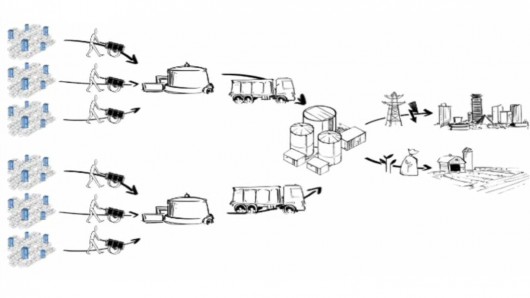Before construction begins, the team have to dig out layers and layers of garbage
It's estimated that around 2.6 billion people around the world make do without any sanitation, including more than 10 million in the slums of Kenya. Still more have to use thinly disguised holes in the ground. A group of MIT students have joined forces to try and create a sustainable toilet solution for those in need. They've developed a low cost, modular sanitation solution which would be operated and maintained by locals and the waste transported to nearby processing plants. Biogas produced from the waste will be used to create electricity and what's left of the human waste turned into fertilizer.
As you complain about the state of the toilets at the latest rock festival, spare a thought for those who have it much worse. A huge chunk of the world's population is either denied any sanitation at all or make use of so-called pit latrines – where holes in the ground are surrounded by ramshackle sheds generally erected using foreign aid funding. Such funding doesn't pay for their upkeep though and they soon fall into disrepair.
The long term aim of the Sanergy project is to create a sustainable sanitation cycle in high density informal settlements where the availability of such services are low. Sanergy is made up of MIT students who have developed a model which will see sanitation centers paying for their own upkeep and also generating income and power for local people.
The project proposes a network of franchised, low cost sanitation centers being constructed in slum areas, like those of Kisumu (one of the largest slums in the world). Each center would measure 10 x 6 feet and provide clean, hygienic shower and toilet facilities to meet the needs of around 200 people. The day-to-day operation of the centers will be franchised to local people who will generate wages and maintenance funds by charging users a small per use or subscription amount of, say, about a dollar a month. Further income could be generated by the sale of basic toiletries.
Sanergy has developed something called the Ecosan system where waste is deposited into air-tight containers. These are collected from the sanitation centers on a daily basis as part of a small collection route licensed to local people. The waste collectors will then transport the containers by handcart to an intermediate processing facility, and from there onto central processing plants.
The processing facility converts the waste into biogas through large-scale anaerobic digestion and feeds it into a combined heat and power engine to generate electricity. The power could then be sold directly to the Kenya Light and Power Company and the national grid through long term purchase agreements. Vermicomposting techniques will convert whatever's left into high-grade fertilizer for onward sale to small-scale and commercial farms.
Sanergy has recently presented its project model to the 13th Annual MIT Venture Capital Conference and is currently raising funds to add 25 more centers to the two it has already built. For the moment the current pilot facilities are being funded by the company but it is hoped that such centers will become self-sustaining in the future. If successful, the model can be repeated in other developing nations.
The following video shows the project in detail:
Copyright © gizmag 2003 - 2010 To subscribe or visit go to: http://www.gizmag.com
